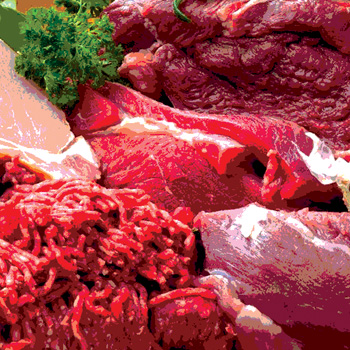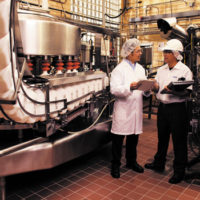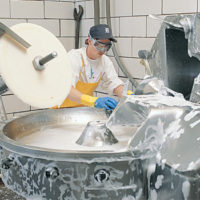I just celebrated my third anniversary as a Medicare cardholder. The time has finally come to sit back and relax a bit and let a younger, more energetic and better-trained generation launch us into the next era of food safety. I’ve earned the right to make those difficult choices about whether to meet publication deadlines or go fishing. So now is a good time to cut bait and forget the flashing icon on my computer screen. No, I’m not putting away my thermocouple thermometer or holstering my brand new LED flashlight just yet. I still enjoy being a sanitarian too much to leave this exciting profession entirely; as the playwright Noel Coward once said, “Work is more fun than fun,” and I fully intend to keep the fun going until I can’t anymore. But just before the fat lady sings, I would like to present a little bit of local regulatory history of the food safety movement as I lived it, and perhaps give a little insight into the future.
Views from the Past
Forty-five years ago I started working as a district sanitarian for the New Jersey State Department of Health. There were eight of us who covered the state in four health districts. Our job was to inspect all state-licensed food establishments and to serve as a resource (most often playing the role of “Bad Cop”) for the local sanitary inspector who, for whatever reason, was faced with a recalcitrant retail food proprietor. Occasionally, we were the ‘epidemiologists du jour’ charged with chasing after foodborne misadventures. Our entire approach to food safety was quite different than it is today. Our main focus was on food adulteration, rather than contamination, and we were very much into the “walls, floor and ceiling” mentality with regard to sanitation. I came into the profession at the tail end of The Jungle (Upton Sinclair’s 1906 novel) era.
The references we had reflected the food protection philosophy at the time. I recall using the 1962 Public Health Service (PHS) Foodservice Sanitation Manual as my basic marching orders, a briefcase full of NSF standards as enforcement adjuncts and a copy of Ehlers & Steel’s Municipal and Rural Sanitation as a text reference. As state sanitarians, we were lucky to have copies of the National Association of Sanitarians’ The Sanitarian’s Desk Reference and Dr. Ben Freedman’s Sanitarian’s Handbook in our office. These were invaluable references when everything else failed.
Our food safety field instrumentation consisted of a bimetal thermometer and a maximum-registering, mercury-filled thermometer in an armored case. That was it. The rest of our gear included a Hobart fat tester, hydrometer, brix and salinity refractometers; a dropper bottle filled with a Malachite Green solution to detect sulfite adulteration in meats; a phosphatase milk testing kit, Mason jars and sealing wax for taking food samples; and a WWII Army surplus metal oil can that was filled with the foulest smelling kerosene to ensure that condemned foods stayed condemned. All this was hauled around in a ’55 Dodge. The tools provided intrigue when I found violations and the Dodge provided the comic relief. Damn, I loved that job.
Forward Ho!
In 1976, the second iteration of the PHS Foodservice Sanitation Manual was issued. It did several important things for those of us in local enforcement, particularly in the way our profession started looking at the retail food industry. Yes, it still emphasized the good ol’ walls, floor and ceiling sanitation paradigm, but it also introduced, albeit subtly, cross-contamination protection and an emphasis on the control of potentially hazardous foods. It was then that I became fascinated with the concept of using both time and temperature as a means of preventing foodborne illnesses in the retail trade. Unfortunately, the ’76 code did not include Hazard Analysis and Critical Control Points (although it certainly was around at that time) or specifics on contamination control. For these, we had to wait until the 1995 Food Code was issued. As a result, much of our enforcement activities were based on what the legal profession cobbled together in the form of case law and lawsuits filed in response to a spate of foodborne illness outbreaks. Seeking redress through the courts was far more expeditious than going through regular governmental channels when it came down to actual food safety.
In about 1980 when I was fairly fresh out of graduate school, I had my first experience as plaintiff’s expert witness in a case involving foodborne intoxication. The defendant’s counsel was a seasoned criminal trial lawyer, and I learned, perhaps the hard way, the importance of knowing the art and science of my profession and using my knowledge, skills and attributes to the best of my ability. I can distinctly remember being asked by the opposing counsel whether I had written anything for which I professed expertise. At the time I hadn’t, and the rest of that session was a battle of wits between attorneys as to whether or not I was qualified to render the opinions I had put in my report regarding my findings in the case. Although our side prevailed, it was about as uncomfortable as sitting on a fire ant hill. This scenario was not so much about my credentials, but rather it had more to do with the lack of information available to both the retail food industry and legal community when dealing with the aftermath of an unintentional incident as well as developing a prevention model so that it would not happen again. However adverse this situation was, it served as a wakeup call. So, for the past three decades, I have doggedly written about environmental health and safety issues and conditions in institutions and retail food establishments that are not found in text books, journals or in the popular press. I’ve always made it a point to address something that I had recently encountered in plying my profession, or what I saw as the next new idea in controlling risk. Needless to say, it’s been quite rewarding.
A Fond Farewell
So, I gently bow out of another era, one in which we’ve witnessed significant changes in attitudes, policies and practices. We’ve seen significant initiatives in consumer protection, and we have begun to question the whole issue of “farm to fork” and sustainability. This will be our future. In thinking ahead, I realize that our science has barely scratched the surface in working with food safety, including embracing the Green movement. There is so much left to do, so many things to find out about food safety strategies and so many ways to discover how to control risks in new cost-effective and cost-efficient ways. Hopefully, we will all seize the opportunities in this field and run with them. We’re bound only by the limits of our imaginations.
Finally, I want to thank all my readers for their support and particularly those who provided feedback…good, bad and indifferent…about my work. I sincerely appreciated every comment, recommendation and suggestion. I’ve enjoyed exchanging ideas, and most importantly, I’ve learned so very much from all of you. I would like to think that we’ve all made a difference for the better.
With warmest regards,
Bob Powitz, Sanitarian
Forensic sanitarian Robert W. Powitz, Ph.D., MPH, RS, CFSP, is principal consultant and technical director of Old Saybrook, CT-based R.W. Powitz & Associates, a professional corporation of forensic sanitarians who specialize in environmental and public health litigation support services to law firms, insurance companies, governmental agencies and industry. Dr. Powitz can be reached at Powitz@sanitarian.com or through his Web site at www.sanitarian.com.
Lessons Learned and a Bit of History




